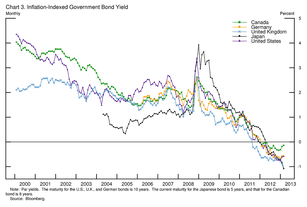
The real interest rate is the rate of interest an investor, saver or lender receives (or expects to receive) after allowing for inflation. It can be described more formally by the Fisher equation, which states that the real interest rate is approximately the nominal interest rate minus the inflation rate.
If, for example, an investor were able to lock in a 5% interest rate for the coming year and anticipated a 2% rise in prices, they would expect to earn a real interest rate of 3%.[1] The expected real interest rate is not a single number, as different investors have different expectations of future inflation. Since the inflation rate over the course of a loan is not known initially, volatility in inflation represents a risk to both the lender and the borrower.
In the case of contracts stated in terms of the nominal interest rate, the real interest rate is known only at the end of the period of the loan, based on the realized inflation rate; this is called the ex-post real interest rate. Since the introduction of inflation-indexed bonds, ex-ante real interest rates have become observable.[2]
- ^ Marc Levinson, 2006, "Guide to Financial Markets", The Economist, page 24
- ^ "FRB: Speech with Slideshow--Bernanke, Long-Term Interest Rates--March 1, 2013". www.federalreserve.gov. Retrieved 2017-03-07.